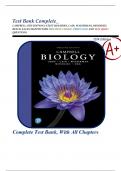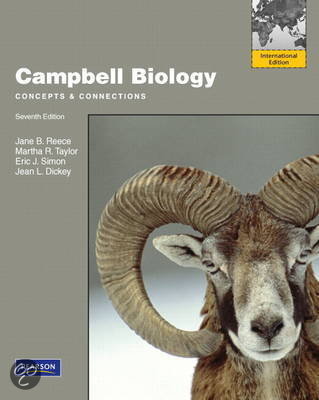Test Bank Complete_
CAMPBELL 12TH EDITION LATEST 2024 (URRY, CAIN, WASSERMAN, MINORSKY,
REECE) EACH CHAPTER WITH MULTIPLE CHOICE, TRUE/FALSE AND SELF QUIZ|
QUESTIONS
12th Edition
,CAMPBELL 12TH EDITION (URRY, CAIN, WASSERMAN, MINORSKY, REECE)
Table Of Contents
Chapter 1 Introduction: Themes In The Study Of Life __________________________________________1
Chapter 2 The Chemical Context Of Life ____________________________________________________17
Chapter 3 Water And The Fitness Of The Environment ________________________________________41
Chapter 4 Carbon And The Molecular Diversity Of Life _______________________________________61
Chapter 5 The Structure And Function Of Large _____________________________________________82
Chapter 6 A Tour Of The Cell ___________________________________________________________110
Chapter 7 Membrane Structure And Function ______________________________________________129
Chapter 8 An Introduction To Metabolism _________________________________________________150
Chapter 9 Cellular Respiration: Harvesting ________________________________________________172
Chapter 10 Photosynthesis _____________________________________________________________200
Chapter 11 Cell Communication ________________________________________________________220
Chapter 12 The Cell Cycle _____________________________________________________________236
Chapter 13 Meiosis And Sexual Life Cycles _______________________________________________257
Chapter 14 Mendel And The Gene Idea ___________________________________________________277
Chapter 15 The Chromosomal Basis Of Inheritance _________________________________________301
Chapter 16 The Molecular Basis Of Inheritance ____________________________________________321
Chapter 17 From Gene To Protein _______________________________________________________340
Chapter 18 Regulation Of Gene Expression _______________________________________________364
Chapter 19 Viruses___________________________________________________________________389
Chapter 20 Biotechnology _____________________________________________________________400
Chapter 21 Genomes And Their Evolution ________________________________________________420
Chapter 23 The Evolution Of Populations_________________________________________________447
Chapter 24 The Origin Of Species _______________________________________________________472
Chapter 25 The History Of Life On Earth _________________________________________________491
Chapter 26 Phylogeny And The Tree Of Life_______________________________________________519
Chapter 27 Bacteria And Archaea _______________________________________________________546
Chapter 28 Protists __________________________________________________________________571
Chapter 29 Plant Diversity I: How Plants ________________________________________________595
Chapter 30 Plant Diversity II: The Evolution Of ___________________________________________615
Chapter 31 Fungi ____________________________________________________________________642
Chapter 32 An Introduction To Animal Diversity __________________________________________665
Chapter 33 Invertebrates ______________________________________________________________689
Chapter 34 Vertebrates ________________________________________________________________717
Chapter 35 Plant Structure, Growth, ____________________________________________________744
,Chapter 36 Resource Acquisition And Transport In _________________________________________764
Chapter 37 Soil And Plant Nutrition ____________________________________________________784
Chapter 38 Angiosperm Reproduction ___________________________________________________805
Chapter 39 Plant Responses To Internal And ______________________________________________825
Chapter 40 Basic Principles Of Animal Form ______________________________________________851
Chapter 41 Animal Nutrition __________________________________________________________869
Chapter 42 Circulation And Gas Exchange________________________________________________886
Chapter 43 The Immune System ________________________________________________________905
Chapter 44 Osmoregulation And Excretion _______________________________________________927
Chapter 45 Hormones And The Endocrine System __________________________________________939
Chapter 46 Animal Reproduction _______________________________________________________956
Chapter 47 Animal Development _______________________________________________________976
Chapter 48 Neurons, Synapses, And Signaling ____________________________________________993
Chapter 49 Nervous Systems __________________________________________________________1007
Chapter 50 Sensory And Motor Mechanisms _____________________________________________1019
Chapter 51 Animal Behavior __________________________________________________________1035
Chapter 52 An Introduction To Ecology And _____________________________________________1054
Chapter 53 Population Ecology ________________________________________________________1074
Chapter 54 Community Ecology _______________________________________________________1102
Chapter 55 Ecosystems ______________________________________________________________1121
Chapter 56 Conservation BIOLOGY And________________________________________________1144
,
, CHAPTER 1 INTRODUCTION: THEMES IN THE STUDY OF LIFE
Chapter 1 of "The Introduction to the Study of Biology" outlines seven overarching themes throughout the book, with a particular
focus on the central theme of evolution. It emphasizes how scientists apply inductive reasoning to formulate broad conclusions and use
deductive reasoning to evaluate hypotheses. The chapter includes questions intended to evaluate a student's grasp of the content,
based on the three main concepts presented.
MULTIPLE-CHOICE QUESTIONS
1) WHICH Of The FOLLOWING Properties Or Processes Do We Associate With Living Things?
A) Evolutionary Adaptations
B) Energy Processing
C) Responding To The Environment
D) Growth And Reproduction
E) All Of The Above
ANSWER: E
TOPIC: Overview
Skill: Knowledge/Application
2) WHICH Of The FOLLOWING Is Not A Theme That Unifies BIOLOGY?
A) Interaction With The Environment
B) Emergent Properties
C) Evolution
D) Reductionism
E) Structure And Function
ANSWER: D
TOPIC: Concept 1.1
Skill: Knowledge/Application
3) WHICH Of The FOLLOWING Sequences Represents The Hierarchy Of Biological Organization From
The Least To The Most Complex Level?
A) Organelle, Tissue, Biosphere, Ecosystem, Population, Organism
B) Cell, Community, Population, Organ System, Molecule, Organelle
C) Organism, Community, Biosphere, Molecule, Tissue, Organ
D) Ecosystem, Cell, Population, Tissue, Organism, Organ System
E) Molecule, Cell, Organ System, Population, Ecosystem, Biosphere
ANSWER: E
TOPIC: Concept 1.1
Skill: Knowledge/Application
4) A Localized Group Of Organisms That Belong To The Same Species Is Called A
A) Biosystem.
B) Community.
C) Population.
D) Ecosystem.
E) Family.
ANSWER: C
TOPIC: Concept 1.1
Skill: Knowledge/Application
1





